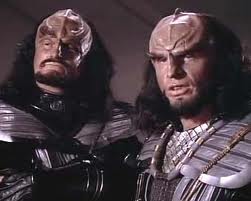“Heart of Glory”
Written by Maurice Hurley and Herbert Wright & D.C. Fontana
Directed by Rob Bowman
Season 1, Episode 19
Production episode 40271-120
Original air date: March 21, 1988
Stardate: 41503.7
Captain’s Log: The Enterprise is sent to investigate a battle that took place in the Neutral Zone. They find a Talarian freighter drifting, with indeterminate lifesigns, as said signs are located near the damaged engineering section. There is a concern about Romulan activity (Picard says that’s a name they haven’t heard in “a while,” which means, I guess, that “Angel One” was “a while” ago), and Riker beams over with Data and La Forge to investigate the freighter. (Yar stays behind because Picard wants her at tactical in case the Romulans are cloaked nearby.)
La Forge detects metal fatigue in the hull, figuring it to be five minutes before the hull collapses. Data finds the survivors, who turn out to be three Klingons, one of whom is in bad shape. Yar manages to beam them back despite the interference from the engines.
The Klingons report to sickbay, where their leader, Captain Korris, and his second, Konmel, explain that they were passengers on the freighter when it was attacked by Ferengi, who were using Klingon weapons. Korris claims to have helped the freighter captain defeat the Ferengi. Picard is skeptical of Korris’s story, but allows them to rest and eat. When the third Klingon dies, Korris pries his eyes open and he, Konmel, and Worf scream to the heavens—a Klingon death ritual, as Data explains, warning the dead that a Klingon warrior is about to arrive.
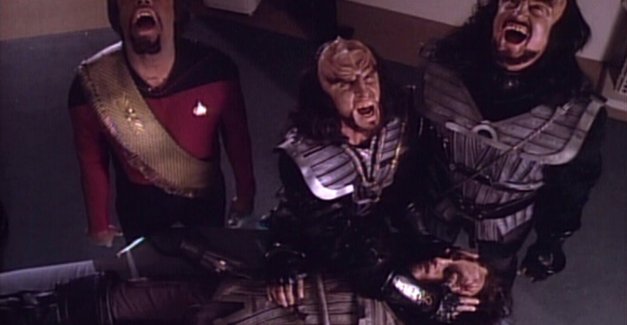
A Klingon cruiser shows up, and its captain, K’Nera, explains that Korris and the others are criminals who stole a freighter and destroyed a battle cruiser sent to bring them home. Yar takes them into custody, where they are neither scanned nor searched, thus enabling them to remove pieces off their uniforms and assemble weapons. (Oops.)
Worf asks to address K’Nera. He pleads on Korris’s behalf, saying that what burns in their blood also burns in his. (There’s probably medication Dr. Crusher can prescribe for that.) He asks that they be sent to a primitive planet where they may at least die on their feet. K’Nera, however, has no choice.
Korris and Konmel then break out of the brig, making Worf’s pleading pointless. Konmel is killed by one of Yar’s security people. Korris takes over engineering, holding a phaser on the dilithium chamber—one shot will destroy the ship.
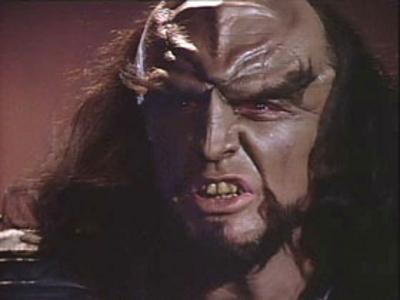
Korris’s plan is to force Picard to give them the stardrive section, so he and Worf can find endless battle. Worf asks him in return where in all his talk of battle and glory are the words duty, honor, and loyalty—without which a warrior is nothing? This conversation also allows Worf to get close enough to shoot Korris.
Picard reports to K’Nera that Korris and Konmel are dead—and Worf assures him that they died well. K’Nera also asks Worf to consider serving on a Klingon vessel when his tour on the Enterprise is done, to which Worf says he’d be honored. After K’Nera signs off, Worf assures Picard that he was just being polite. Yes, he really said that, with a straight face.
Can’t We Just Reverse the Polarity?: La Forge attaches a Visual Acuity Transmitter to his VISOR so the bridge can see what he sees when he joins the away team on the freighter. Picard gets so sucked into seeing how La Forge views the universe that he temporarily forgets about the mission until Riker rather snidely reminds him. The VISOR processes a ton of information in a variety of spectra, and Picard is also surprised to see that La Forge sees Data very differently because he’s an android—which means Data looks even more different than other humans to him than to those with normal sight. This makes La Forge’s easy friendship with Data even more impressive, honestly (and is the only way Picard’s line about how seeing through his eyes allows him to understand La Forge better makes sense).
There is No Honor in Being Pummeled: We finally learn Worf’s story: when the Romulans attacked the Khitomer outpost, he was found under the rubble by a Starfleet officer and raised by him and his wife on the farming colony of Gault. Korris guesses that he had trouble assimilating, which Worf confirms, saying he learned to control it. This backstory would be expanded upon in several episodes, most notably “Sins of the Father,” which would provide more details of the massacre and of Worf’s Klingon family, “Family,” where we meet Worf’s human fosterparents, “Birthright,” where we meet other survivors of the Khitomer attack, and the Deep Space Nine episode “Let He Who Is Without Sin…,” in which we learn of Worf’s difficulties controlling his Klingon passions as a child, which resulted in the death of a classmate.
This is also the first episode that makes it clear that Worf has spent almost no time among his own people, that what he knows of being Klingon is all instinct and study, not experience. This dichotomy would be a recurring issue for the character throughout his appearances not only on this show, but on DS9 as well.
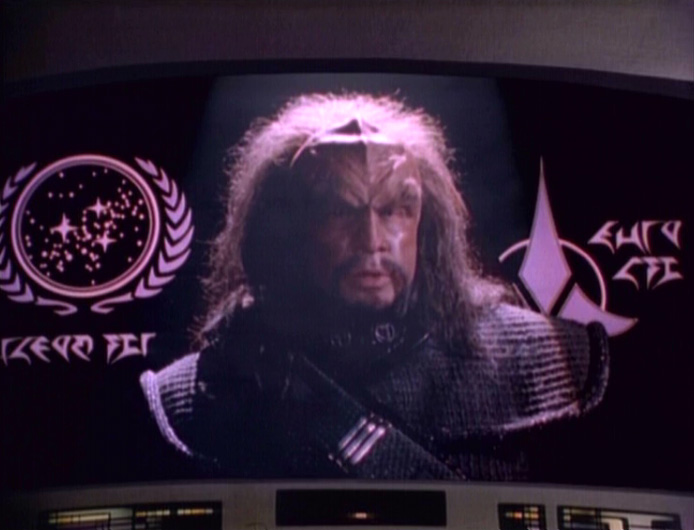
Welcome Aboard: David Froman has tremendous presence as K’Nera, and Charles H. Hyman is wonderfully snotty as Konmel. But the big story here is the first of an unparalleled twelve roles played on all four modern Star Trek series by the redoubtable Vaughn Armstrong. (It’s thirteen if you count the Mirror Universe version of Maxwell Forrest separately from the mainline version of Admiral Forrest, the latter being the only recurring role Armstrong played.) However, this is Armstrong’s only appearance on TNG.
I Believe I Said That: “And Mr. Worf? The bridge wouldn’t be the same without you.”
Picard, showing Worf some love.
Trivial Matters: While Worf’s presence always implied this, it is this episode that confirms that the Federation and the Klingon Empire are now allies, thus fulfilling the promise made by the Organians way back in “Errand of Mercy.” The communication screen shown whenever K’Nera talks to the Enterprise displays both nations’ logos on either side of him, symbolizing the cooperation.
Korris makes reference to “the traitors of Kling,” implying that Kling is the name of the Klingon homeworld, an idea that probably made sense right up until Vaughn Armstrong said the word “Kling” out loud. Star Trek VI: The Undiscovered Country would refer to the Klingon homeworld as Qo’noS, which would stick, with “Kling” mercifully never referred to again.
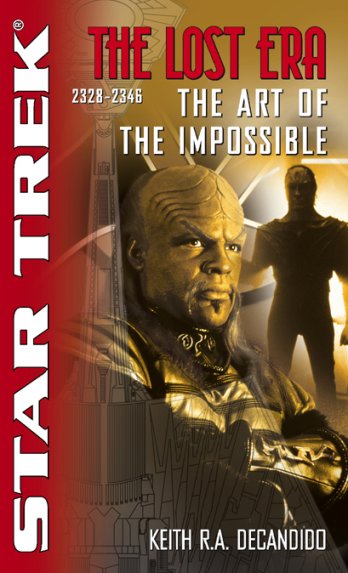 Worf refers to his foster brother attending Starfleet Academy with him. We meet that brother in “Homeward,” and their time at the Academy is dramatized in the young adult novels Worf’s First Adventure, Line of Fire, and Survival by Peter David.
Worf refers to his foster brother attending Starfleet Academy with him. We meet that brother in “Homeward,” and their time at the Academy is dramatized in the young adult novels Worf’s First Adventure, Line of Fire, and Survival by Peter David.
The Khitomer Massacre is dramatized in my own novel The Lost Era: The Art of the Impossible (which also features a six-year-old Worf running around with a bat’leth).
Make it So: “They died well.” It’s funny, I’m a huge Klingon fan, and have been ever since I first saw Michael Ansara’s Kang in “Day of the Dove” as a small, impressionable child. In my career as a Star Trek fiction author, I’ve carved out a reputation as “the Klingon guy,” having written a butt-load of Klingon-focused fiction both in prose and comics, including a series of books that take place on a Klingon ship.
So you’d think I’d like this episode more, wouldn’t you?
The problem is that it just isn’t a very good story, and the acting doesn’t elevate it. While Armstrong would go on to a distinguished career as a Trek guest—including a most excellent recurring turn as Admiral Forrest on Star Trek: Enterprise—he’s overly histrionic here. One of the joys of watching modern Trek is viewing the progression of Michael Dorn’s skills as an actor, but the downside of that is that he started off mediocre and got much much better, and “Heart of Glory” is right smack in the mediocre phase.
In their defense, I doubt that anyone could sound good delivering the overly mannered, tiresomely metaphoric Klingon dialogue. “Like the hunter that spawned you, join in the struggle of life and death.” “What burns in their eyes fires my soul.” “I too wish they could fly free.” “I have tasted your heart!” “Do not deny the challenge of your destiny. Get off your knees, and soar—open your eyes and let the dream take flight!” “My words were dust upon the ground.”
The plot itself goes nowhere fast. Korris’s group’s guilt is obvious from jump, and even Picard suspects it early on, which makes you wonder why nobody bothered to scan their uniforms for the parts that would make a weapon before putting them in the brig. The lengthy freighter sequence with La Forge’s VISOR serves no useful function except as padding (at least they had the brains to put the padding at the beginning of the episode where you don’t notice it as much), and the jump-cut-to-the-ceiling of Worf’s death scream for Korris is just silly.
Plus the entire notion that Worf might be compromised simply because he’s the same species as the prisoners is absurd reasoning. The script itself provides ample reason for Worf to be conflicted, but those are private conversations among Korris, Konmel, and Worf—why would Picard and Riker be concerned generally if they’re not privy to those talks, unless they think that poorly of Worf’s ability to reason?
Some claim that the establishment of Klingons as being creatures of honor and duty was at odds with the portrayal of them in the original series as straight-up thug-like bad guys, but I contend that the portrayal here and in subsequent Klingon stories has its roots in the Klingons’ very first appearance in “Errand of Mercy.” Watch Kor and then watch this episode—the only thing separating them is a bumpy forehead.
The Klingon poltical arc that would start in the third season’s “Sins of the Father” and end with DS9‘s “Tacking Into the Wind” was one of the high points of modern Trek, and that arc provided some great Klingon episodes. But this first one was a forgettable mess.
Warp factor rating: 4.
Keith R.A. DeCandido has written quite a bit about the Klingons over his career as a Star Trek fiction writer, such as the novels Diplomatic Implausibility, The Lost Era: The Art of the Impossible, The Brave and the Bold Book 2, Articles of the Federation, A Singular Destiny, and A Time for War, a Time for Peace; the novellas Enterprises of Great Pitch and Moment in Slings and Arrows and The Unhappy Ones in Seven Deadly Sins; the short story “loDnI’pu’ vavpu’ je” in Tales from the Captain’s Table and “Family Matters” in Mirror Universe: Shards and Shadows; and the comic book Alien Spotlight: Klingons. But his biggest contribution to Klingon lore was the series of novels that took place on the I.K.S. Gorkon, a Klingon battle cruiser: A Good Day to Die, Honor Bound, Enemy Territory, and A Burning House. Yes, he likes Klingons. For more on Keith, go to his home page, his blog, his Facebook page, or his Twitter feed.










